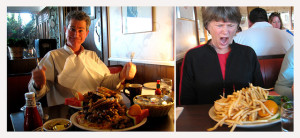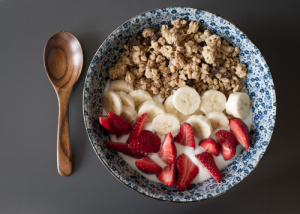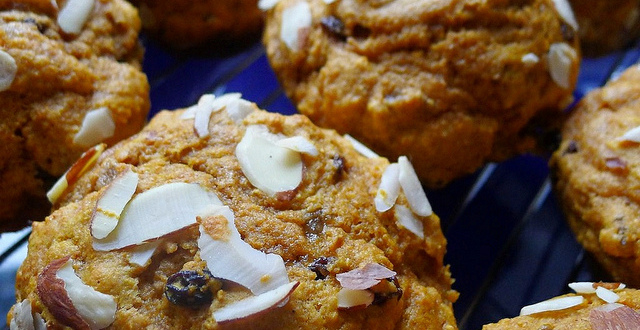by Michelle Sutton-Kerchner
As a chill enters the air, the cravings start. We want to linger a little over that hot mug of coffee, consider a pumpkin muffin, or maybe a warm cookie. Here’s how to enjoy without overindulging…
The oven is fired up after months of hibernation. All seats are taken at the coffee shop, which was recently deserted as patrons hustled to summer destinations. Comfort-food season is here. Learn how to deal before it hunkers down to wait out the winter.
Winning Diet?

Depriving yourself of a warm slice of baguette or a scone to accompany your tea will not be the difference between health and extra weight, lethargy, and all other negative association with carbs. Recent findings continue to prove what has been known all along: Everything in moderation, with a side serving of fitness.
A study published in the Journal of the American Medical Association analyzed several popular diets. The goal was to feed dieters the elusive secret to weight-loss success. Low-carb, low-fat, low-sugar, brand-named, and elimination diets were studied.
After years of competing for the top position on the list of success, no diet trumped the next. A magic combination of foods and supplements for weight loss does not exist. Those annoying pop-up ads on your computer are distractions in the Internet sea we surf. “Eat this one [weird] fruit and lose belly fat forever,” should be ignored.
Less Is More
Carbohydrates versus fats, meat versus other protein sources, sugar versus substitute. Give up the battle and go on what is being termed as the “low diet.” The low diet allows you to consume a balanced diet, include the occasional not-so-healthy favorites, and still shed pounds. The magic: portion control.
Eat less, weight less is the theory. And, unlike many other diets, it simply makes sense. It doesn’t require the juice from fruit native to remote lands. It doesn’t eliminate key foods you know you will eventually eat again, thereby gaining back those excess pounds. It does require you to eat sensible amounts, mindfully.
It has been proven people consume more calories when served from larger portions. Did you ever notice food often remains in a small serving bowl of something? The host may fret about not having enough of this. However, when guests serve themselves from a smaller dish, they tend to take less.
At home, keep serving bowls off the kitchen table. (At least if you get seconds, you’ll have to walk to reach them!) If seconds are out of reach, you will be less likely to overeat.

When you buy in bulk, transfer foods into smaller containers. The larger the package, the more snackers tend to over-consume from it. Beware of restaurant dining, with their super-sized servings. Split a meal with a friend or set aside half to take home.
Cutting out a few forkfuls at every meal can make a difference. You begin to gauge the true amount needed to satisfy your hunger. As you take more appropriate portions for your stomach size, you will find you eat less. Over time, this new style of eating becomes automatic. Eating less = weighing less. It also leaves a little extra room, and calorie consumption, for a small serving of your favorite dessert. That sounds delicious!
Portion Sizes: The USDA recommends protein sources should equal three ounces in a meal. A standard portion of beef, chicken, or fish should be the size of a deck of playing cards. A serving of pasta should be about the size of a scoop of ice cream. A standard cereal serving is a half-cup.
Add Variety

Unlike fad diets, one specific food group is not emphasized here. Make healthful choices from all food groups, in moderate portions. Create a colorful plate. More colors usually signifies a wider range of nutrients. Your health, which is more important than a number on the scale, requires a variety of healthful foods and regular exercise.
Don’t be a clock-watcher. Eat when you are hungry. Trying to hold off until mealtime often leads to over-eating. Soften a ferocious appetite with a high-fiber snack, even if before dinner. An apple makes a great meal starter. It’s healthy, and it may prevent you from eating a large baked potato or two scoops of pasta. It is okay to spoil your appetite for those extras. Snacking when hungry also keeps blood-sugar levels stable, which helps you feel and eat better.
Watch What You Eat

Literally. Don’t multitask the enjoyment of a good meal with that of TV, texting, or working. Let food be your entertainment when you eat. Focus and understand what it is to be satiated. You will better appreciate the baked goods that do come your way.
Sources
“No Clear Winner Among Popular Diets, Analysis Finds,” by Amy Norton at www.everydayhealth.com.
“The ‘Low’ Diet: 4 Simple Rules for Weight Loss Success,” by Bonnie Taub-Dix at www.everydayhealth.com.
www.cdc.gov.
Image Credits
Pumpkin muffins (introductory photo): https://www.flickr.com/photos/llstalteri/8374994960
Build muscle: www.flickr.com/photos/mcas_cherry_point/6714749721
Restaurant portions: www.flickr.com/photos/emdot/74960580
Healthy bowl: www.flickr.com/photos/aryaziai/8717570333
Place setting: www.flickr.com/photos/dinnerseries/5261413989
 Fitness & Wellness News Your Source for Fitness News, Wellness News, Health News, and Nutrition News!
Fitness & Wellness News Your Source for Fitness News, Wellness News, Health News, and Nutrition News!




